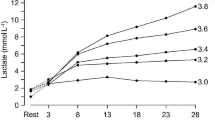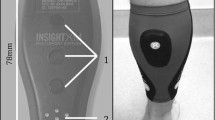Summary
The aim of the study was to examine whether the difference in lactate concentration in different blood fractions is of practical importance when using blood lactate as a test variable of aerobic endurance capacity. Ten male firefighters performed submaximally graded exercise on a cycle ergometer for 20–25 min. Venous and capillary blood samples were taken every 5 min for determination of haematocrit and lactate concentrations in plasma, venous and capillary blood. At the same time, expired air was collected in Douglas bags for determination of the oxygen consumption. A lactate concentration of 4.0 mmol·1−1 was used as the reference value toi compare the oxygen consumption and exercise intensity when different types of blood specimen and sampling sites were used for lactate analysis. At this concentration the exercise intensity was 17% lower (P<0.01) when plasma lactate was compared toi venous blood lactate, and 12% lower (P<0.05) when capillary blood lactate was used. Similar discrepancies were seen in oxygen consumption. The results illustrated the importance of standardizing sampling and handling of blood specimens for lactate determination to enable direct comparisons to be made among results obtained in different studies.
Similar content being viewed by others
References
Acevedo EO, Goldfarb AH (1989) Increased training intensity effects on plasma lactate, ventilatory threshold, and endurance. Med Sci Sports Exerc 21:563–568
Buono MJ, Yeager JE (1986) Intraerythrocyte and plasma lactate concentrations during exercise in humans. Eur J Appl Physiol 55:326–329
Decker DG, Rosenbaum JD (1942) The distribution of lactic acid in human blood. Am J Physiol 138:7–11
Farell PA, Wilmore JH, Coyle EF, Billing JE, Costill DL (1979) Plasma lactate accumulation and distance running performance. Med Sci Sports 11:338–344
Foxdal P, Sjödin B, Rudstam H, Östman C, Östman B, Hedenstierna G (1990) Lactate concentration differences in plasma, whole blood, capillary fingerblood and erythrocytes during submaximal graded exercise in humans. Eur J Appl Physiol 61:218–222
Harris R, Dudley G (1989) Exercise alters the distribution of ammonia and lactate in blood. J Appl Physiol 66:313–317
Johnsson RE, Edwards HT, Dill DB, Wilson JW (1944) Blood as a physiochemical system. XIII. The distribution of lactate. J Biol Chem 157:461–473
Kumagai S, Tanaka K, Matsuura Y, Matzuzaka A, Hirakoba K, Asano K (1982) Relationships of the anaerobic threshold with the 5 km, 10 km, and 10 mile races. Eur J Appl Physiol 49:1323
Morgan DW, Baldini FD, Martin PE, Kohrt WM (1989) Ten kilometer performance and predicted velocity atVO2 max among well-trained male runners. Med Sci Sports Exerc 21:78–83
Noble BJ, Borg G, Jacobs I, Ceci R, Kaiser P (1983) A categoryratio perceived exertion scale: relationship to blood lactate, muscle lactate and heart rate. Med Sci Sport Exerc 15:523–528
Sahla SD, Morishima HO, James LS, Adamsons Jr K (1964) Lactate and pyruvate gradients between red blood cells and plasma during acute asphyxia. J Appl Physiol 19:1100–1104
Sjödin B, Jacobs I (1981) Onset of blood lactate accumulation and marathon running performance. Int J Sports Med 2:23–26
Yoshida T, Takeuchi N, Suda Y (1982) Arterial versus venous blood lactate increase in the forearm during incremental bicycle exercise. Eur J Appl Physiol 50:87–93
Author information
Authors and Affiliations
Additional information
The study was performed at the Department of Clinical Physiology University Hospital, S-75185 Uppsala, Sweden
Rights and permissions
About this article
Cite this article
Foxdal, P., Sjödin, A., Östman, B. et al. The effect of different blood sampling sites and analyses on the relationship~ between exercise intensity and 4.0 mmol ·1− blood lactate concentration. Europ. J. Appl. Physiol. 63, 52–54 (1991). https://doi.org/10.1007/BF00760801
Accepted:
Issue Date:
DOI: https://doi.org/10.1007/BF00760801




